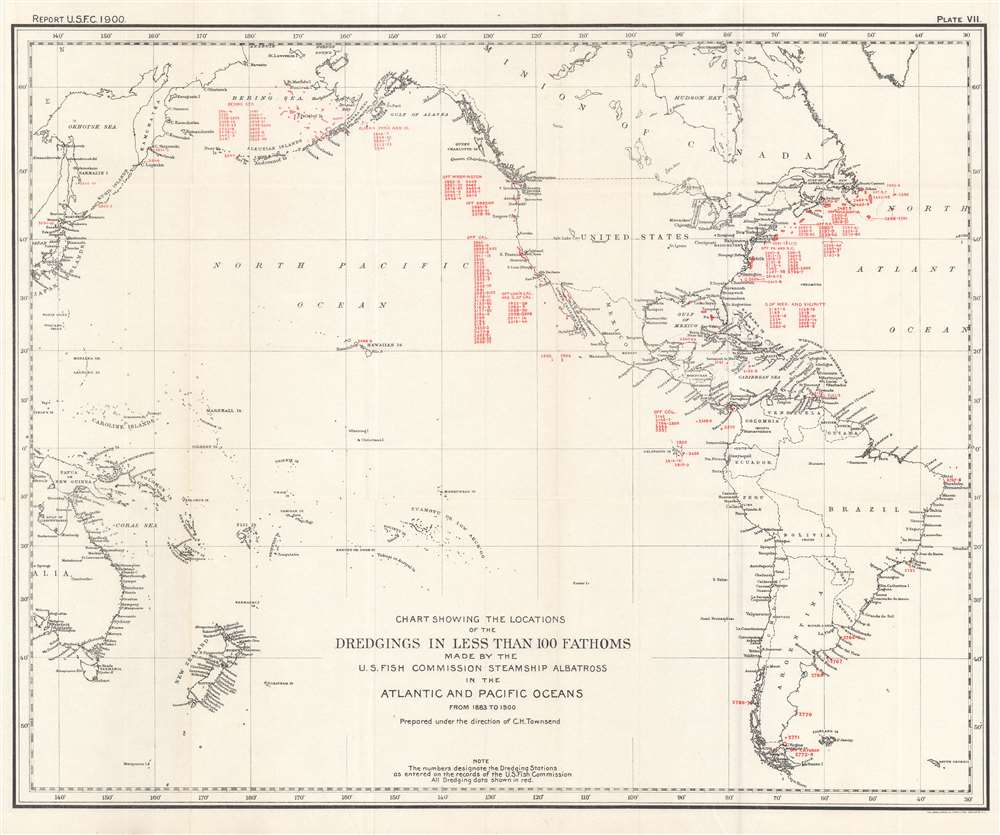1900 U.S. Fish Commission Map of Atlantic and Pacific Ocean Dredgings
AtlanticPacificDredgings-townsend-1900
Title
1900 (dated) 19.75 x 24.25 in (50.165 x 61.595 cm) 1 : 37600000
Description
The USS Albatross
This USS Albatross, also known as the USFC Albatross in scientific papers, was the first specifically built marine research vessel. Albatross operated in the Atlantic between December 1882 and November 1887, when she began her voyage to the Pacific Ocean. She arrived at the Straits of Magellan on January 23, 1888, and then continued up the coast of South America, stopping in the Galapagos briefly in April 1888. She operated along the U.S. Pacific coast and as far north as the Bering Sea and as far south as Panama between 1888 and 1898, when she was converted into an auxiliary cruiser for service during the Spanish-American War. After this work was finished, she sailed for Mexico, but did not see combat before peace treaties were signed. She immediately underwent conversion back to being a research vessel. After the retrofit, Albatross left San Francisco on August 23, 1899 and spent the next few months in the Central and South Pacific, before arriving in Yokohama, Japan, on March 4, 1900. Albatross continued her research work until she was transferred to the Navy on May 2, 1917, for service during World War I. She served with the American Patrol Detachment as a gunboat and protected tankers transporting oil and petroleum in the Caribbean and the Gulf of Mexico. After World War I, Albatross returned to research work, until she was decommissioned on October 29, 1921. She was sold to Thomas Butler and Company of Boston in June 1924, without her library, equipment, or instruments. Butler converted her into a school ship, then refitted her as a training ship for 'nautical students and cadets'. She left for Europe with 119 students on board on July 12, 1927. However, the students filtered off the ship at a succession of ports and by the time the Albatross reached Hamburg the crew demanded that she be auctioned off to satisfy their salaries. The paper trail goes cold in 1928 and her ultimate fate is unknown.Publication History and Census
This map was created under the supervision of Charles Haskins Townsend for the U.S. Fish Commission. It was published in the 1900 U.S. Fish Commission report to Congress and printed by the Norris Peters Company. An example of the separate map is cataloged in OCLC and is part of the collection at the New York Botanical Garden. The report in which it was printed are cataloged in OCLC.CartographerS
Charles Haskins Townsend (September 29, 1859 – January 28, 1944) was an American zoologist. He served as assistant United States Fish Commissioner, was in charge of deep-sea explorations on the USS Albatross, and at the turn of the century served as chief of the Fish Commission's fisheries division. From 1902 go 1937 he was director of the New York Aquarium at Castle Garden. During his career he testified as an expert at The Hague, served as president of the American Fisheries Society, and was elected a fellow of the New York Academy of Sciences. He wrote extensively on fisheries, whaling, fur seals, deep-sea exploration and zoology, including ornithology and herpetology. More by this mapmaker...
Norris Peters (c. 1834 – July 15, 1889) was a Washington D.C. based photo-lithographer active in the late 18th and early 19th century whom Scientific American called 'one of Washington's most eccentric and mysterious figures.' Peters was born and educated in Pennsylvania. He relocated as a young man to Washington D.C. where he took work as an examiner for the United States Patent Office. During his work with the patent office he became fascinated with the emergent process of photolithography. In 1869 Peters secured substantial venture capital of about 100,000 USD from an unknown investor and founded The Norris Peters Company at 458 Pennsylvania Avenue. Their printing offices have been described as 'unequaled in this or any other country.' From these offices Peters pioneered the development of American photo-lithography. For nearly a generation he held a near monopoly on government photo-lithographic printing. Among their more notable contracts included numerous maps for congressional reports, maps of the U.S. Coast Survey, maps of the U.S. Geological Survey, Mexican currency for the State of Chihuahua, and the Official Gazette of the Patent Office. Peters also maintained an interesting social life and was a confidant to many of the most powerful figures in Congress. He was also a bon vivant known for being an excellent cook and hosting lavish dinners, the invitations to which were 'never declined'. Despite being socially active he never married and died a confirmed bachelor. Following Peters' death in 1889 his business was taken over by Henry Van Arsdale Parsell who administered it until his own death in 1901. The company then merged with Webb & Borcorselski, another D.C. lithography firm, and was renamed Webb & Borcorselski-Norris Peters. They continued to publish under this name well into the mid 20th century. Learn More...

